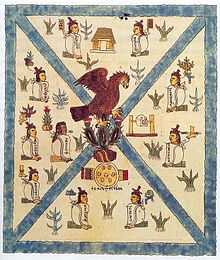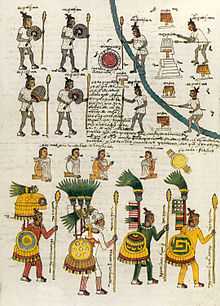Codex Mendoza

The Codex Mendoza is an Aztec codex, created fourteen years[1] after the 1521 Spanish conquest of Mexico with the intent that it be seen by Charles V, the Holy Roman Emperor and King of Spain. It contains a history of the Aztec rulers and their conquests, a list of the tribute paid by the conquered, and a description of daily Aztec life, in traditional Aztec pictograms with Spanish explanations and commentary.
The codex is named after Don Antonio de Mendoza, then the viceroy of New Spain, who may have commissioned it. It is also known as the Codex Mendocino and La colección Mendoza, and has been held at the Bodleian Library at Oxford University since 1659. It was removed from public exhibition on December 23, 2011.[2]
History
The Codex Mendoza was hurriedly created in Mexico City, to be sent by ship to Spain. The fleet was attacked by French privateers, and the codex, along with the rest of the booty, taken to France. There it came into the possession of André Thévet, cosmographer to King Henry II of France. Thévet wrote his name in five places on the codex, twice with the date 1553. It was later bought by the Englishman Richard Hakluyt for 20 French francs. Some time after 1616 it was passed to Samuel Purchase, then to his son, and then to John Selden. The codex was deposited into the Bodleian Library at Oxford University in 1659, 5 years after Selden's death, where it remained in obscurity until 1831, when it was rediscovered by Viscount Kingsborough and brought to the attention of scholars.
Content
Written on European paper, it contains 71 pages, commonly said to be divided into three sections:
- Section I, 16 pages, is a history of the Aztec people from 1325 through 1521 — from the founding of Tenochtitlan through the Spanish conquest. It lists the reign of each ruler and the towns conquered by them.
- Section II, 39 pages, provides a list of the towns conquered by the Triple Alliance and the tributes paid by each.
- Section III, 16 pages, is a pictorial depiction of the daily life of the Aztecs.
However, there is a fourth section:
- Section IV, 20 pages, is an encoded accounting of the value of both the cargo of the ship and assets n the new colony
Section I
Gallery
-

Folio 2 recto
Founding of Tenochtitlan. -

Folio 4 verso
Conquests of Chimalpopoca. -

Folio 5 verso
Conquests of Itzcoatl. -

Folio 10 recto
Conquests of Axayacatl. -

Folio 13 recto
Conquests of Ahuitzotl.
Section II
Gallery
-

Folio 17 verso
-

Folio 20 recto
-

Folio 37 recto
-

Folio 43 recto
-

Folio 46 recto
-

Folio 47 recto
-

Folio 52 recto
Section III
Gallery
-

Folio 60 recto
Punishments and chores of children, ages 11 to 14. -

Folio 61 recto
(top) 15-year-old boys beginning training in the military or the priesthood.
(bottom) A 15-year-old girl gets married. -

Folio 64 recto
(top) Duties of novice priests.
(bottom) Ranks awarded to warriors. -

Folio 65 recto
(top) Ranks award to priest-warriors.
(bottom) Imperial officers. -

Folio 67 recto
(top) Warriors scout a town at night in preparation for an attack.
(middle) Negotiations after surrender.
(bottom) High-ranking commanders. -

Folio 69 recto
Moctezuma II's palace.
References
- ↑ "1534 - The Codex Mendoza app, Title Page (spanish translation) as released Dec 2014 by the National Institute of Anthropology and History (INAH) of Mexico".
- ↑ "The Treasures Exhibition".
- Berdan, Frances F.; Anawalt, Patricia Rieff (1997). The Essential Codex Mendoza. University of California Press. ISBN 978-0-520-20454-6.
- Ross, Kurt (1978). Codex Mendoza: Aztec Manuscript.
- Kupriienko, Sergii; Talakh, Viktor (2013) [2013]. Codex Mendoza (russian edition). Kyiv: Видавець Купрієнко С.А. ISBN 978-617-7085-00-2. Retrieved 4 September 2013.
External links
| Wikimedia Commons has media related to Codex Mendoza. |